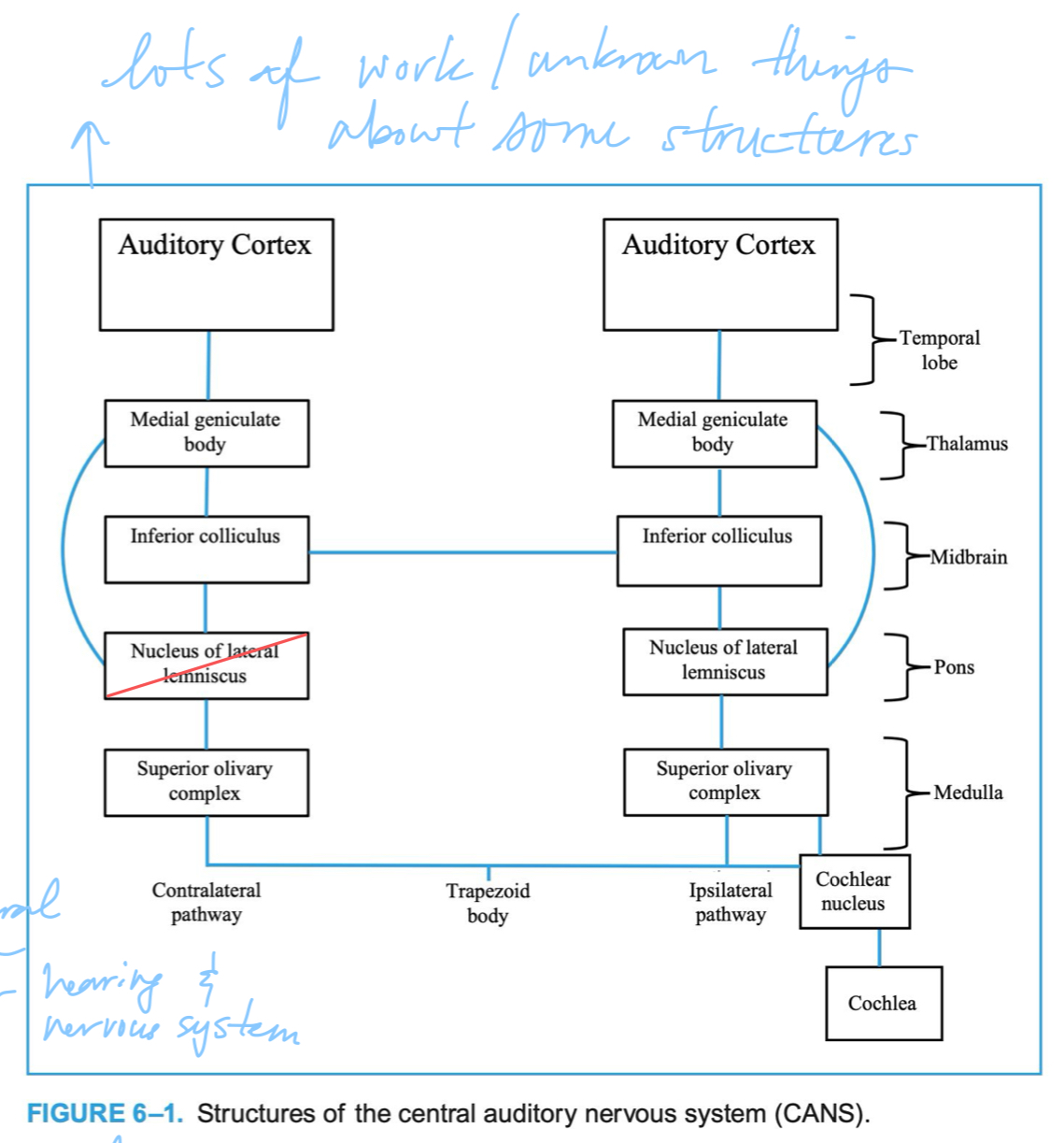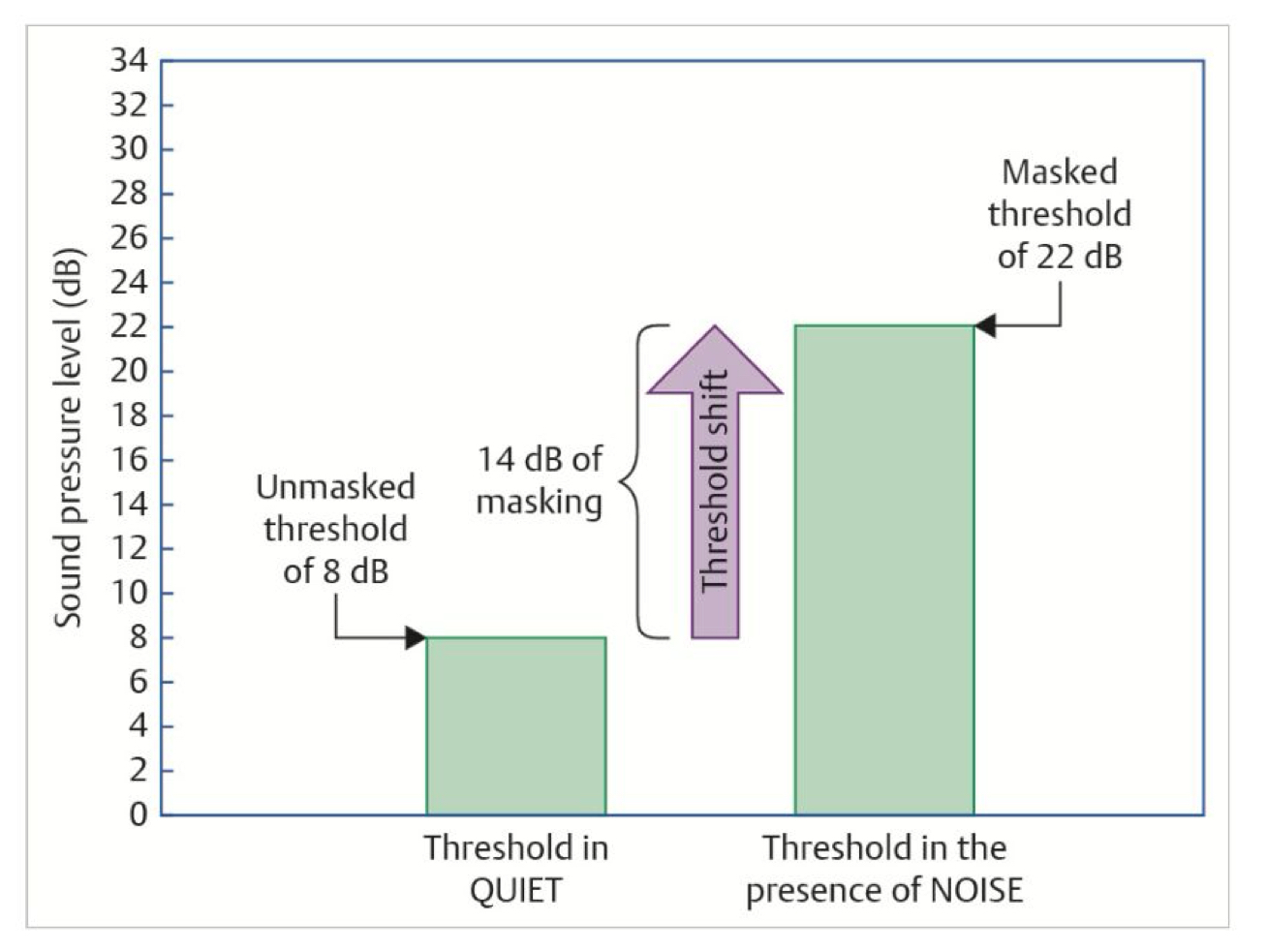EDAU 113 Exam 3
1/70
Earn XP
Description and Tags
Based on study guide provided by the professor and questions from Assignment 2
Name | Mastery | Learn | Test | Matching | Spaced |
|---|
No study sessions yet.
71 Terms
Psychoacoustics
the study of sound perception; what our brains do with sound
Hearing
biological/physiological process occurring through the auditory pathway; passive process that does not require attention
Listening
paying attention and comprehending sounds; an active and conscious process
Measurable levels of perception (auditory perception tasks)
detection, discrimination, and identification
Detection
presence vs absence of stimuli; pure tone audiometry
ex: raise your hand when you hear the “beep”
Discrimination
the noticeable difference between sounds (such as frequency/pitch, intensity/loudness)
ex: can one hear the difference between 10 db SPL and 11 db SPL?
Identification
how many or which sounds are recognizable; word recognition testing during a hearing test
ex: say the word car, say the word please
Range of frequencies audible by humans
20 - 20,000 Hz (by frequency/pitch)
Minimum audibility curve
normal hearing sensitivity

Which frequencies are our ears most sensitive to?
500-4,000 Hz - this is where most speech information occurs

Temporal integration
refers to the effect of signal duration on signal detectability; we can detect signals as short as 10 milliseconds (0.01 sec); pure tones that are less than 0.25 sec will require more amplificaiton to detect
Do we hear quiet sounds better with one or two ears?
hearing sensitivity is better with two ears than one
Threshold
the lowest intensity at which a test subject responds to the presence of the test signal 50% of the time; we don’t need to hear something 100% of the time for it to be a threshold; common test signals for audiology assessments: pure tones, narrowband noise, warbled tones, speech

Presbycusis
age-related hearing loss; decreases in high-frequency hearing sensitivity (2000-8000 Hz) with age

Audiogram
graph or table that shows the thresholds in hearing levels at different frequencies, uses db HL (hearing level), each threshold db SPL value corresponds to a hearing level of 0 db HL; shaded area is where most speech sounds occur

Type (character of hearing loss)
sensorineural (inner ear problem), conductive (external or middle ear problem), mixed (both external or middle and inner ear problem)
ex: hearing loss could be caused by nerve damage, cochlear damage, fluid behind the ear, etc.
degree (character of hearing loss)
severity of the hearing loss (mild, moderate, severe, etc.)
configuration (character of hearing loss)
pattern or trend
ex: flat, rising, sloping, cookie bite, peak

Hearing pathways
done either by air conduction or bone conduction; both pathways are tested in clinical audiometry
Air conduction
traditional means of audition, where the medium is air
Bone conduction
cochlear stimulation by setting the bones of the skull into vibration; it bypasses the conductive mechanism (outer and middle ear) and directly stimulated sensory structures (inner ear)
3 bone conduction mechanism
inertial, compressional, and osseotmpanic
Action potential
firing of the nerves and sending information up the auditory pathway and up to the brain; produced by neurons that communicate with hair cells in the cochlea
Tuning curve
hearing test for each individual nerve fiber; each curve represents a different neuron being tested

Characteristic frequency
the frequency that a particular neuron is most sensitive to
Relationship between neural firing and stimulus intensity
the firing rate of an auditory neuron increases as the stimulus intensity increases within its dynamic range, and eventually plateaus

Place coding
high-frequency sounds produce firing from neurons at the base of the cochlea, low-frequency sounds produce firing at the apex
Temporal coding
the precise timing of neural events (such as action potentials) and when neurons fire at a rate period that mimics the stimulus (also known as phase locking)
Phase locking
Neurons produce action potentials in a way that mimics the stimulus–more specifically, APs may occur at a period that matches the period of the stimulus frequency (lower frequency will have a longer period)
Afferent auditory pathway
A bundle of about 30,000 neural fibers are twisted together like a rope, and they transmit information from the hair cells of the cochlea towards the brain stem
Efferent auditory pathway
there is a smaller set of about 500 neural fibers sending information from the brain stem towards the cochlear hair cells; these descending neurons are called the olivocochlear pathway
Binaural hearing vs monaural hearing
monaural hearing - refers to hearing and processing sound with one ear
binaural hearing - hearing and processing sounds with both ears
Diotic
simultaneous presentation of the same sound to the left and right ears

Dichotic
simultaneous presentation of a stimulus to one ear and a different stimulus to the opposite ear

Binaural fusion
refers to when our two ears combine information and form one coherent message
Binaural beats
Perceptual phenomenon, when two slightly different pure tone frequencies are presented (one to each ear) at the same time and intensity, creating an auditory illusion of a third tone pulsing on and off (example of how our ears work together)
Binaural summation
our threshold of hearing being about 3 dB better when listening with both ears compared to just one ear, the central auditory system receives redundant information across the two ears, which contributes to increased perception of loudness; we have improved sensitivity to frequency and intensity (with two ears vs. one)
Duplex theory (localization theory)
the CANS uses timing differences and level/intensity differences between the two ears to determine which direction a sound is coming from
Interaural timing differences
sound will reach the ear closest to the stimulus; timing/phase cue
Interaural level differences
sound will be louder at the ear closest to the stimulus; amplitude cue (the other ear will experience less intensity due to head shadow)
Head shadow effect
the head attenuates/reduces intensity of sound

Spiral ganglion
bundle of ascending neurons, helps transmit info from hair cells of cochlea towards the brain stem
Olivocochlear pathway
descending neurons, sending info from brain stem to cochlear hair cells
What percentage of afferent nerve fibers synapse with inner hair cells vs outer hair cells?
95% of fibers go to inner hair cells, remaining 5% go to outer hair cells; each IHC will connect exclusively with ~20 nerve fibers, ~10 OHCs will connect to a single nerve fiber
What are the four lobes of the brain?
Parietal, occipital, temporal, frontal
What structures make up the brainstem?
medulla, pons, midbrain (between pons and thalamus)
Superior olivary complex (SOC)
most peripheral structure receiving input from each cochlea, controls activity of both middle ear muscles (tensor tympani and stapedius) through efferent activity

Inferior colliculus
midbrain structure receiving much information from SOC; info from lower levels is synthesized and combined with other senses (e.g., visual, vestibular, and somatosensory) to form localization response

Tonotopic organization
place coding, different frequencies are coded at different places along the basilar membrane; high frequency sounds produce firing from neurons at the base of the cochlea, low-frequency sounds produce firing at the apex

McGurk effect
perceptual phenomenon that demonstrates an interaction between hearing and vision in speech perception
ex: hearing “ba” but seeing “fa” due to the illusion
Volley theory
A group of neuron fibers may code for frequency from using their pooled response, working together helps reproduce the signal
Masking
when one sound (the signal) can no longer be heard because of interference from another sound (the masker, aka the noise)
ex: “I didn’t hear you because the water was running”

Threshold shift
Masking is a process in which the threshold of one sound (signal) is raised due to the presentation of another sound (masker)

Effective masking/kneepoint
0-dB effective masking, refers to the lowest level of competing noise that causes a signal to be inaudible

Upward spread of masking
Low-frequency sounds are good at masking high-frequency sounds, may be due to the shape of the wave envelope on the basilar membrane

Critical band
Concept that refers to which frequencies are most efficient at masking the signal

Forward masking
when the masker ends before the signal begins, making the masking of the signal occur forward in time
Backward masking
when the masker begins after the signal ends, making the masking of the signal occur forward in time
Energetic masker
white/static noise, no meaning to it
Informational masker
speech information
Equal loudness contour
lines on the phon scale visually representing each phon level, at any point along any of the curves, the perceived loudness would be the same

Phon
used to tell us an order of magnitude–which sound is louder than another but it does not quantify the difference (ordinal scale)
Timbre
quality of a tone determined by the whole spectrum that provides the richness or body of a sound, difference in harmonics
Cochlear amplifier
function of the cochlea where low-level sounds are enhanced by the outer hair cells, damage to OHCs reduces our ability to hear quiet sounds, which usually develops from ototoxicity (noise exposure, aging)
Loudness recruitment
occurs with damage to the OHCs in the cochlea; refers to an abnormal growth of loudness, reduced dynamic range
Frequency selectivity
ability to hear out (i.e., resolve) small differences in frequency of the auditory system
What is “SPL” an acronym for? Does an individual with normal hearing sensitivity require greater dB SPL to detect 125 Hz or 2,000 Hz?
SPL = sound level pressure
A person with normal hearing would need a greater dB SPL for 125 Hz
Why does the audiogram use dB HL instead of dB SPL?
It was designed for clinical use to explain things clearly to patients by having nicer numbers to work with; it is a scale that normalizes the hearing threshold and measures how much an individual’s hearing deviates from normal hearing level
What type of hearing loss is characterized by normal bone conduction thresholds and abnormal air conduction thresholds?
Conductive hearing loss, possibly due to a problem in the middle ear such as liquid behind the ear drum
Describe what happens to the firing rate of a neuron once it has reached a point of saturation
the firing rate will eventually plateau, even if the stimulus intensity increases
Describe how a wide range of stimulus intensities is coded by neurons with different spontaneous firing rates.
See image!
